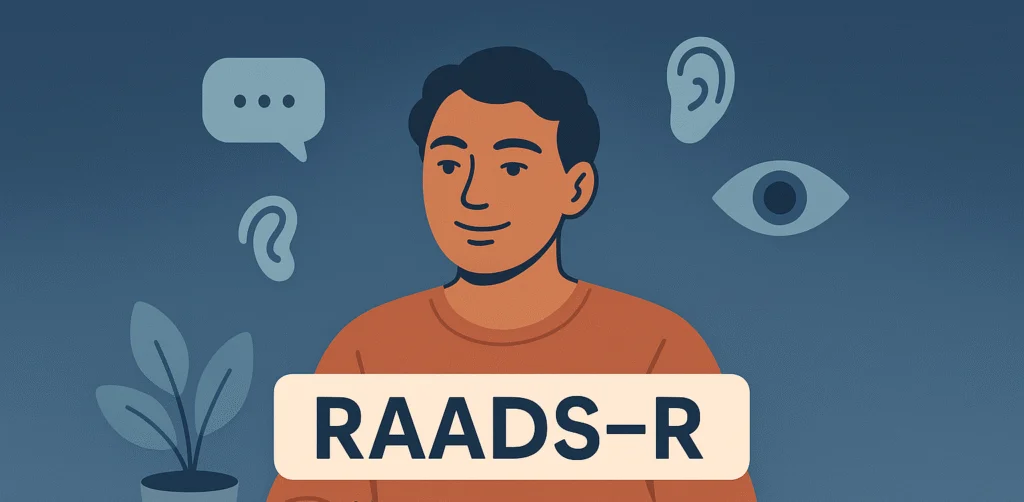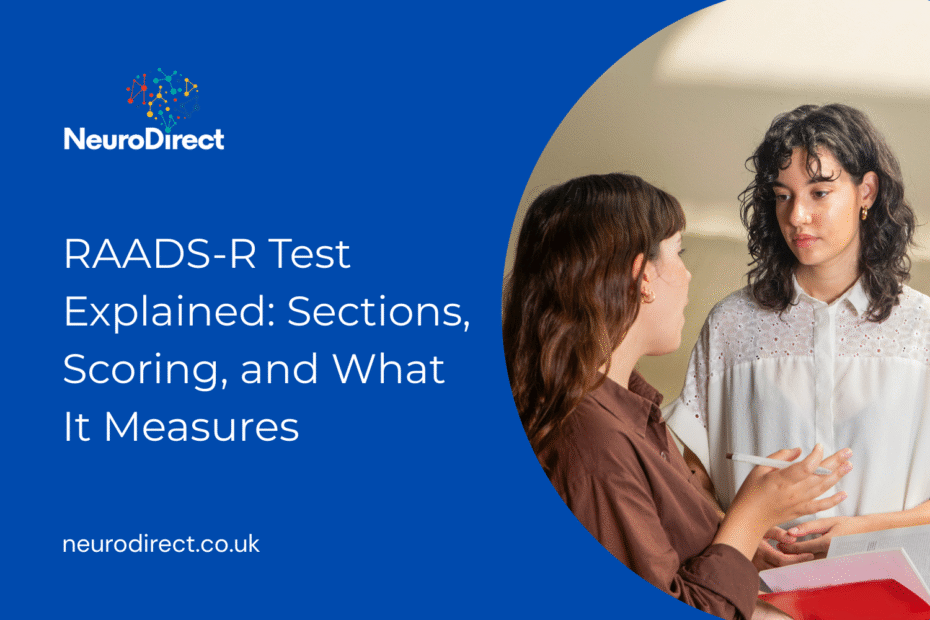RAADS-R Test Explained: Sections, Scoring, and What It Measures
The RAADS-R Test (Ritvo Autism Asperger Diagnostic Scale – Revised) is one of the most widely used adult autism screening tools. If you’ve ever wondered whether your lifelong experiences could be explained by autism spectrum traits, this test is a structured, research-backed way to explore that possibility.
Unlike shorter questionnaires such as the Autism Quotient (AQ) test, which give a quick snapshot of traits, the RAADS-R takes a deeper dive. It looks at multiple areas of life — from social connections to sensory processing — and is designed to uncover patterns that might have been masked or overlooked, especially in adulthood.
The RAADS-R was originally created for use in clinical settings, but today it can be taken online through trusted platforms like Neurodirect. This makes it easier for anyone in the UK or beyond to explore their autistic traits before deciding whether to pursue a full diagnostic assessment.
In this guide, we’ll cover:
- The four sections of the RAADS-R test and what each measures
- How scoring works and what different score ranges mean
- Why the RAADS-R is valued for adult autism screening
- The difference between RAADS-R and other autism screening tools
- How to take the test online and next steps after your results
Whether you’re completely new to autism screening or comparing different tests, this article will give you the clarity you need to make an informed choice — and help you decide if now is the right time to take the RAADS-R test.

What Is the RAADS-R Test?
Developed by Dr. Riva Ritvo and colleagues, the RAADS-R is an 80-question self-report questionnaire designed for adults aged 16+ with average or above-average intelligence. It’s intended as a screening tool — not a stand-alone diagnostic test — and can be used both online and in clinical settings.
Its main goal is to identify lifelong autism spectrum traits that may have been overlooked, especially in adults who’ve adapted or masked their differences.
The Four Sections of the RAADS-R Test
The RAADS-R is divided into four domains, each covering a core area where autistic traits often appear.
1. Social Relatedness
This section explores how you connect with others, including:
- Understanding social cues
- Making and maintaining friendships
- Comfort in group settings
2. Circumscribed Interests
Focuses on the depth and intensity of interests, including:
- Highly specific hobbies or topics
- Preference for routines and predictability
- Strong attachment to specific objects or subjects
3. Language
Assesses differences in communication style, such as:
- Literal interpretation of language
- Difficulty with small talk
- Preference for factual over emotional conversation
4. Sensory-Motor
Looks at sensory sensitivities and motor behaviours, including:
- Over- or under-sensitivity to sounds, lights, textures
- Repetitive movements (stimming)
- Differences in coordination
How the RAADS-R Is Scored
Each of the 80 statements is rated based on whether it’s true:
- Now and when you were younger
- Now only
- Only when you were younger
- Never true
Answers are given point values. The total score can range from 0 to 240, with 65 or higher suggesting significant autistic traits.
Score breakdown by section:
- Social relatedness: max 117 points
- Circumscribed interests: max 28 points
- Language: max 12 points
- Sensory-motor: max 83 points
Effectiveness of the RAADS-R Test
The RAADS-R has been widely studied for its accuracy in identifying autism spectrum traits in adults, and research supports its role as a reliable screening tool. A 2021 study published in Autism Research found that the RAADS-R demonstrates high sensitivity (ability to correctly identify autistic individuals) and good specificity (ability to exclude non-autistic individuals) when used in appropriate contexts (source).
These findings suggest that the RAADS-R can be particularly useful for:
- Adults seeking a late autism diagnosis
- Clinicians needing a validated screening tool before referral
- People who have learned to mask autistic traits and may not be flagged by shorter questionnaires
However, the RAADS-R is not a diagnostic tool on its own. While it is effective at indicating the likelihood of autism traits, a formal assessment by a qualified professional is necessary for an official diagnosis. This ensures that factors such as ADHD, anxiety, or other developmental conditions are fully considered.
In short, the RAADS-R is a valuable first step in the autism identification process — offering a structured, evidence-based way to better understand your traits before seeking further evaluation.
What the Scores Mean
- Below 65: Autism less likely, though traits may still be present.
- 65–100: Traits present — may warrant further assessment.
- 100+: Stronger presence of traits, particularly if spread across multiple domains.
It’s important to note that high scores don’t confirm autism — only a qualified clinician can diagnose.
Why People Choose the RAADS-R
- Comprehensive coverage: Goes beyond short autism screeners like the AQ-10 or AQ-50.
- Validated by research: Studies show high sensitivity (correctly identifying autism) and specificity (correctly excluding non-autistic individuals).
- Useful for late diagnosis: Especially for women and others whose traits may have been missed in childhood.
Can You Take the RAADS-R Online?
Yes. The RAADS-R can be completed online in around 15–30 minutes. Taking it via a reputable source ensures accurate scoring and clear next-step guidance.
Next Steps After Taking the RAADS-R
If your score suggests autistic traits:
- Speak to your GP or mental health professional to discuss formal assessment.
- Use your results to better understand your needs in work, study, and relationships.
- Explore resources and support communities for autistic adults.
Take the RAADS-R Test Today
If you’re ready to explore whether autism traits could explain your experiences, you can take the RAADS-R test online for free.
